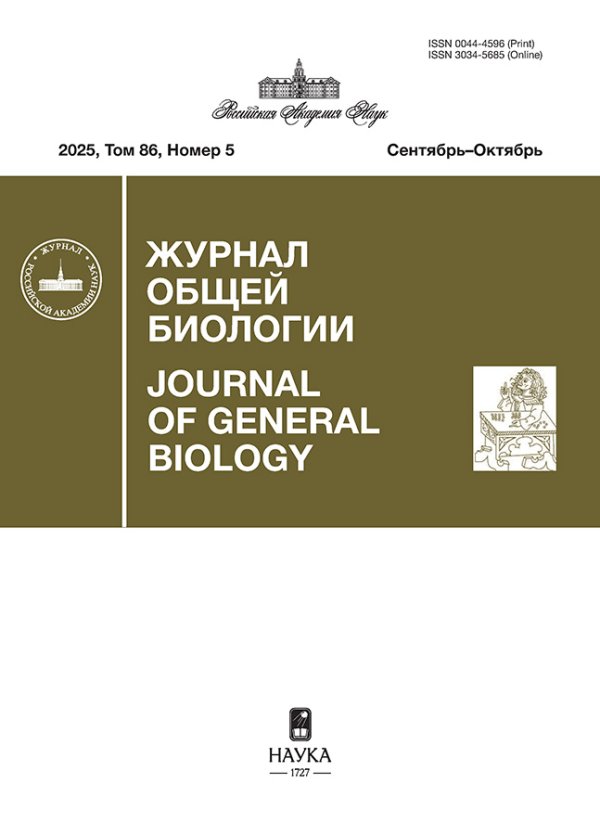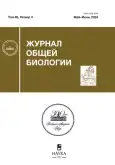Реконструкция межвидовых взаимодействий в моделях популяционной динамики на основе индивидуально-ориентированного подхода
- Авторы: Шереметьев А.Д.1, Михайлов А.И.1,2, Бобырев А.Е.3, Криксунов Е.А.2
-
Учреждения:
- Всероссийский НИИ рыбного хозяйства и океанографии
- Московский государственный университет им. М. В. Ломоносова
- Институт проблем экологии и эволюции им. А. Н. Северцова РАН
- Выпуск: Том 85, № 3 (2024)
- Страницы: 230-243
- Раздел: (воспроизводится в журнале “Current Contents”)
- URL: https://gynecology.orscience.ru/0044-4596/article/view/652463
- DOI: https://doi.org/10.31857/S0044459624030042
- EDN: https://elibrary.ru/vdbfkh
- ID: 652463
Цитировать
Полный текст
Аннотация
Предмет настоящей статьи – установление связи между трофическими функциями как свойствами взаимодействующих популяций в целом и особенностями индивидуального пищедобывательного поведения консументов. В статье проводится классификация моделей “хищник–жертва” общего положения и трофических функций как неотъемлемой компоненты этих моделей. Показано, что простые предположения об индивидуальном поведении хищников и жертв приводят к вполне определенному виду трофической функции – кусочно-линейной зависимости Ардити–Гинзбурга или ее “сглаженной” версии. Полученные теоретические результаты верифицированы с помощью специально разработанной имитационной модели, описывающей взаимодействие между потребителем и кормовыми объектами на индивидуальном уровне.
Об авторах
А. Д. Шереметьев
Всероссийский НИИ рыбного хозяйства и океанографии
Email: abobyrev@mail.ru
Россия, Окружной проезд, 19, Москва, 105187
А. И. Михайлов
Всероссийский НИИ рыбного хозяйства и океанографии; Московский государственный университет им. М. В. Ломоносова
Email: abobyrev@mail.ru
Московский государственный университет им. М. В. Ломоносова, философский факультет
Россия, Окружной проезд, 19, Москва, 105187; Ленинские горы, учебно-научный корпус “Шуваловский”, Москва, 119234А. Е. Бобырев
Институт проблем экологии и эволюции им. А. Н. Северцова РАН
Автор, ответственный за переписку.
Email: abobyrev@mail.ru
Россия, Ленинский просп., 33, Москва, 119071
Е. А. Криксунов
Московский государственный университет им. М. В. Ломоносова
Email: abobyrev@mail.ru
Московский государственный университет им. М. В. Ломоносова, биологический факультет, кафедра ихтиологии
Россия, Ленинские горы, 1, стр. 12, Москва, 119234Список литературы
- Аджабян Н.А., Логофет Д.О., 1992. Динамика размеров популяций в трофических цепях // Проблемы экологического мониторинга и моделирования экосистем. СПб.: Гидрометеоиздат. Т. 14. С. 135–153.
- Базыкин А.Д., 1985. Математическая биофизика взаимодействующих популяций. М.: Наука. 182 с.
- Бигон М., Харпер Дж., Таунсенд К., 1989. Экология. Особи, популяции и сообщества: В 2-х т. Т. 2. М.: Мир. 477 с.
- Булгакова Т.И., Бобырев А.Е., 2018. Роль трофологических исследований в анализе многовидового промысла // Журн. общ. биологии. Т. 79. № 6. С. 461–470.
- Гинзбург Л.Р., Гольдман Ю.И., Раилкин А.И., 1971. Математическая модель взаимодействия двух популяций “хищник–жертва” // Журн. общ. биологии. Т. 32. № 6. С. 724–730.
- Ивлев B.С., 1947. Некоторые вопросы пищевой конкуренции животных // Успехи соврем. биологии. Т. 24. № 6. С. 417–432.
- Ивлев В.С., 1955. Экспериментальная экология питания рыб. М.: Пищепромиздат. 272 с.
- Колмогоров А.Н., 1972. Качественное изучение математических моделей динамики популяций // Пробл. кибернетики. Т. 25. С. 100–106.
- Михайлов А.И., Бобырев А.В., Булгакова Т.И., Шереметьев А.Д., 2019. Возвращаясь к вопросу о популяционной регуляции: обобщенная модель формирования пополнения промысловых популяций рыб // Журн. общ. биологии. Т. 80. № 6. С. 418–426.
- Михеев В.Н., 2006. Неоднородность среды и трофические отношения у рыб. М.: Наука. 191 с.
- Михеев В.Н., Бобырев А.Е., Криксунов Е.А., Михеев А.В., 1997. Стратегии поиска корма молодью рыб: Исследование на математической модели // Вопр. ихтиологии. Т. 37. № 2. С. 242–247.
- Свирежев Ю.М., Логофет Д.О., 1978. Устойчивость биологических сообществ. М.: Наука. 352 с.
- Тютюнов Ю.В., Титова Л.И., 2018. От Лотки–Вольтерра к Ардити–Гинзбургу: 90 лет эволюции трофических функций // Журн. общ. биологии. Т. 79. № 6. С. 428–448.
- Тютюнов Ю.В., Титова Л.И., Сурков Ф.А., Бакаева Е.Н., 2010. Трофическая функция коловраток-фитофагов (Rotatoria). Эксперимент и моделирование // Журн. общ. биологии. Т. 71. № 1. С. 52–62.
- Arditi R., Abillon J.M., Vieira da Silva J., 1978. A predator–prey model with satiation and intraspecific competition // Ecol. Model. V. 5. № 3. P. 173–191.
- Arditi R., Akçakaya H.R., 1990. Underestimation of mutual interference of predators // Oecologia. V. 83. № 3. P. 358–361.
- Arditi R., Ginzburg L.R., 1989. Coupling in predator-prey dynamics: ratio-dependence // J. Theor. Biol. V. 139. № 3. P. 311–326.
- Bazykin A.D., Berezovskaya F.S., Denisov G.A., Kuznetzov Yu.A., 1981. The influence of predator saturation effect and competition among predators on predator–prey system dynamics // Ecol. Model. V. 14. № 1–2. P. 39–57.
- Beddington J.R., 1975. Mutual interference between parasites or predators and its effect on searching efficiency // J. Anim. Ecol. V. 44. № 1. P. 331–340.
- Crowley P.H., Martin E.K., 1989. Functional responses and interference within and between year classes of a dragonfly population // J. North Am. Benthol. Soc. V. 8. № 3. P. 211–221.
- DeAngelis D.L., Goldstein R.A., O’Neill R.V., 1975. A model for trophic interaction // Ecology. V. 56. № 4. P. 881–892.
- Fox W.W., 1970. An exponential yield model for optimizing exploited fish populations // Trans. Am. Fish. Soc. V. 99. P. 80–88.
- Gause G.F., 1934. The Struggle for Existence. Baltimore: Williams and Wilkins. 163 p.
- Gentleman W., Leising A., Frost B., Strom S., Murray J., 2003. Functional responses for zooplankton feeding on multiple resources: a review of assumptions and biological dynamics // Deep-Sea Res. II. V. 50. P. 2847–2875.
- Getz W.M., Westerhoff H.V., Hofmeyr J.-H.S., Snoep J.L., 2003. Control analysis of trophic chains // Ecol. Model. V. 168. P. 153–171.
- Gibson G.A., Musgrave D.L., Hinckley S., 2005. Non-linear dynamics of a pelagic ecosystem model with multiple predator and prey types // J. Plankton Res. V. 27. P. 427–447.
- Ginzburg L.R., 1998. Assuming reproduction to be a function of consumption raises doubts about some popular predator–prey models // J. Anim. Ecol. V. 67. № 2. P. 325–327.
- Harrison G.W., 1995. Comparing predator–prey models to Luckinbill’s experiment with Didinium and Paramecium // Ecology. V. 76. № 2. P. 357–374.
- Hassell M.P., Varley G.C., 1969. New inductive population model for insect parasites and bearing on biological control // Nature. V. 223. P. 1133–1137.
- Holling C.S., 1959. Some characteristics of simple types of predation and parasitism // Can. Entomol. V. 91. P. 385–398.
- Holling C.S., 1965. The functional response of predators to prey density and its role in mimicry and population regulation // Memoirs of the Entomological Society of Canada. V. 45. P. 3–60.
- Ivlev V.S., 1961. Experimental Ecology of the Feeding of Fishes. New Haven: Yale Univ. Press. 302 p.
- Jeschke J.M., Kopp M., Tollrian R., 2002. Predator functional responses: Discriminating between handling and digesting prey // Ecol. Monogr. V. 72. P. 95–112.
- Koen-Alonso M., 2007. A process-oriented approach to the multi-species functional response // From Energetics to Ecosystems: The Dynamics and Structure of Ecological Systems / Eds Rooney N., McCann K.S., Noakes D.L.G. Springer. Р. 1–36.
- Leslie P.H., 1948. Some further notes on the use of matrices in population mathematics // Biometrika. V. 35. P. 213–245.
- Leslie P.H., Gower J.C., 1960. The properties of a stochastic model for the predator–prey type of interaction between two species // Biometrika. V. 47. № 3/4. P. 219–234.
- Lotka A.J., 1925. Elements of Physical Biology. Baltimore: Williams and Wikins. 460 p.
- Mesnil B., Rochet M.-J., 2010. A continuous hockey stick stock–recruit model for estimating MSY reference points // ICES J. Marine Sci. V. 67. № 8. P. 1780–1784.
- Pella J.S., Tomlinson P.K., 1969. A generalized stock-production model // Bull. Inter-Amer. Trop. Tuna Comm. V. 13. P. 421–496.
- Rosenzweig M.L., MacArthur R.H., 1963. Graphical representation and stability conditions of predator-prey interactions // Am. Nat. V. 97. P. 209–223.
- Schaefer M.B., 1954. Some aspects of the dynamics of populations important to the management of the commercial marine fisheries // Bull. Inter-Am. Trop. Tuna Comm. V. 1. № 2. P. 27–56.
- Solomon M.E., 1949. The natural control of animal populations // J. Anim. Ecol. V. 18. P. 1–35.
- Sutherland W.J., 1983. Aggregation and the ‘ideal free’ distribution // J. Anim. Ecol. V. 52. P. 821–828.
- Trân J.K., 2008. A predator–prey functional response incorporating indirect interference and depletion // Verh. Internat. Verein Limnol. V. 30. № 2. P. 302–305.
- Tyutyunov Yu., Titova L., Arditi R., 2008. Predator interference emerging from trophotaxis in predator–prey systems: An individual-based approach // Ecol. Complex. V. 5. № 1. P. 48–58.
- Volterra V., 1926. Fluctuations in the abundance of a species considered mathematically // Nature. V. 188. P. 558–560.
- Yodzis P., 1994. Predator-prey theory and management of multispecies fisheries // Ecol. Appl. V. 4. P. 51–58.
Дополнительные файлы








